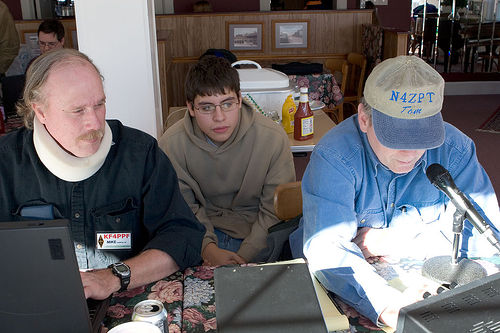This is the slide show and audio from a presentation I gave at the August 2012 Alexandria Radio Club meeting. This presentation is based on information I hav…
Video Rating: 5 / 5

An amateur Radio Repeater (kb5avy) on 444.150 MHZ, following Hurricane Katrina, became one of the few link between New Orleans and the outside world. Old fas…
Video Rating: 4 / 5


AM + repeater = what I will do if I get an Intermediate license. Trying to
cajole mum to let me try for Foundation, so I may use a digital K2K mode,
or a weather map SSTV mode.
FM voice isn’t just nice. It is what is used over 95% of the time in
emergencies and public service events It’s used for tactical nets, which
are the backbone of any emergency – first to activate and last to close.
The NTS, morse code are nice,as a last resort, if ever used for
emergencies. they are nice, but a rusty tool that folks like yourself
overemphasize. Read the latest ARRL PS book and update yourself…Maybe
we’ll get some young experimenters and rebuild this old fart hobby.
Rebuild! Yes, we really need to breath new life into Amateur Radio
FM voice is nice, but remember you can get a CW siganl through with a lot
less power and a much simpler and lower antennna. If you ask me, i want any
option that is available, any chance of survival is better than no chance!
If you read the description, it says they used a repeater on 444.150 MHz.
It is not Morse code, it was VOICE. FM voice communications FYI. If you
take the time to check out modern Ham gear, you will notice it is quite
advanced, and coming lower in price everyday. The video covers many faces
of Ham radio modes used. There are times when voice can not pass and CW or
digital modes are needed. By using NVIS techniques, you can work a 300 mile
area with very little power. This is what military do.
Using morse code?. Watch “katrina, the untold story. Use those paddles, By
the time you Morse code that a woman is in labor, need a boat, need a
chopper after that, and have officials talk to eachother, tactical (short
and time critical) comms to coordiate, good luck. The traditions of ham
radio are nice. Give me at least voice on FM for starters. AM and CW are
nice but lets cathc up with what we are now not inventing anymore and we
wait for commercial radio mfgrs. to “give us”.
TS-590 Current Draw Measurements
The 30A shunt arrived today and I quickly rigged it up with a small (7.5Ah)
gel-cel to measure actual current draw.
One thing I learned: the radio’s Power control has no affect upon the
output power in Tune mode (you’re probably saying ‘well duh!’). So I found
an 1/8 inch phone plug in my junk box, shorted the two contacts and plugged
it into the Key jack. Here’s what I measured/calculated:
5W 8.4A
10W 9.0A
15W 10.2A
20W 11.4A
25W 13.2A
30W 13.8A
35W 14.4A
40W 15A
45W 16.2A
50W 17.4
Using the table in this video:
Portable Solar Power – a Primer for the Radio Amateur
So if I’m going to operate the TS-590 ‘picnic portable’ I calculate that
I’ll need a battery with about 10Ah of capacity for each hour of operation,
assuming 50% transmit and 50% rcv.
I have been thinking about this since my first Field Day, 2012. This was
incredibility interesting and answered a lot of my questions! I enjoyed the
breakdown of the charge controllers. At least at first with my budget I’m
probably going with PWM, but it’s good to know other options are there for
when it’s time to upgrade and improve. Thanks so much!! k4eqm 73
I didn’t make a specific recommendation on panels because at the end of
the day, they pretty much all do the same thing. You should look for the
size, output, and efficiency rating that you can afford for your
application. Some brands I like are Sharp, LG, and Keyocera.
excellent presentation. Thank you, Greg
Thank you!
Excellent info. Thanks! What do you recommend for brands/sources of panels
to buy? I appreciate your recommendations on specific Charge Controllers,
but didn’t hear anything about panels (except the mention of Harbor
Freight).
Hey there, Where did you get the adapter plugs that go from the Goal Zero
4.7mm plug to Anderson Power Pole? Thanks!
You have three options: 1). Buy one of the GZ adapter cables and cut the
end off 2). Buy the 4.7mm plugs from Digikey and make one 3). Utilize the
female cigarette lighter socket and purchase a male cig to PP adapter from
Powerwerx.
Thank you for the quick reply! 🙂 Great presentation by the way… KH6FM
Great video! I am thinking of building myself a solarpanel to charge
batteries while doing QRP at my summerhouse. This information gave me a lot
more on my feet! 73 de SM6YZC
great video, its really handy I could bring it everywhere specially when I
go on hiking..
I hesitated when I saw how long this was but well worth it. I’ve just
started thinking about this for some field work with something other than
an HT. Thanks!
Great video! Any chance of getting a copy of your PowerPoint presentation?
what is a good micro ssb radio